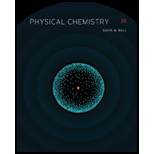
Interpretation:
The expressions to calculate the work and heat for the four steps of a Carnot cycle are to be stated. The
Concept introduction:
The Carnot cycle represents the relationship between the efficiency of a steam engine and the temperatures. It was given by Carnot who stated that every engine gets the heat from a high-temperature reservoir. Some of the heat is converted to the work during the process. The Carnot cycle has four major steps:
Step 1: Reversible isothermal expansion
Step 2: Reversible adiabatic expansion
Step 3: Reversible isothermal compression
Step 4: Reversible adiabatic compression
Answer to Problem 3.65E
The expressions to calculate the work and heat for the four steps of a Carnot cycle are given below.
The
The total work and heat of the cycle is
The value of
Explanation of Solution
For the Carnot cycle, the first and the third step are reversible isothermal processes.
On the other hand, the second and the fourth step are reversible adiabatic processes. So, the expressions to calculate the heat for four steps can be written as shown below.
The variables
From the first law of
The work done for reversible adiabatic processes is given by the formula given below.
Therefore, the expressions to calculate the work for second and the fourth steps can be written as shown below.
Assume
Total heat can be calculated as shown below.
Substitute the values in the above equation as shown below.
Work done for the first and third step can be calculated as shown below.
Substitute the values in the above equation as shown below.
Work done for the second and fourth step can be calculated as shown below.
Substitute the values in the above equation as shown below.
The work of the cycle is calculated by using the formula given below.
Substitute the values in the above equation as shown below.
The entropy change is calculated by the formula given below.
The steps first and the third are reversible isothermal processes; so, the temperature is constant, and at a constant temperature, the heat change is constant. The values of changes in the energy, that is,
The expressions to calculate the work and heat for the four steps of a Carnot cycle are given below.
The
The total work and heat of the cycle is
The value of
Want to see more full solutions like this?
Chapter 3 Solutions
PHYSICAL CHEMISTRY-STUDENT SOLN.MAN.
- What is the product of the reaction? F3C. CF3 OMe NaOH / H₂Oarrow_forwardWhat would you expect to be the major product obtained from the following reaction? Please explain what is happening here. Provide a detailed explanation and a drawing showing how the reaction occurs. The correct answer to this question is V.arrow_forwardPlease answer the question for the reactions, thank youarrow_forward
- What is the product of the following reaction? Please include a detailed explanation of what is happening in this question. Include a drawing showing how the reagent is reacting with the catalyst to produce the correct product. The correct answer is IV.arrow_forwardPlease complete the reactions, thank youarrow_forwardConsider the synthesis. What is compound Y? Please explain what is happening in this question. Provide a detailed explanation and a drawing to show how the compound Y creates the product. The correct answer is D.arrow_forward
- What would be the major product of the following reaction? Please include a detailed explanation of what is happening in this question. Include steps and a drawing to show this reaction proceeds and how the final product is formed. The correct answer is B. I put answer D and I don't really understand what is going on in the question.arrow_forwardWhat is the product of the following reaction? Please explain what is happening in this question. Provide a detailed explanation and a drawing showing how the reagent is reacting with the catalysts to product the correct product. The correct answer is B.arrow_forwardWhat is the missing intermediate 1 and the final product 2. Please include a detailed explanation explaining the steps of malonic ester synthesis. Please include drawings of the intermediate and how it occurs and how the final product is former.arrow_forward
 Principles of Modern ChemistryChemistryISBN:9781305079113Author:David W. Oxtoby, H. Pat Gillis, Laurie J. ButlerPublisher:Cengage Learning
Principles of Modern ChemistryChemistryISBN:9781305079113Author:David W. Oxtoby, H. Pat Gillis, Laurie J. ButlerPublisher:Cengage Learning General Chemistry - Standalone book (MindTap Cour...ChemistryISBN:9781305580343Author:Steven D. Gammon, Ebbing, Darrell Ebbing, Steven D., Darrell; Gammon, Darrell Ebbing; Steven D. Gammon, Darrell D.; Gammon, Ebbing; Steven D. Gammon; DarrellPublisher:Cengage Learning
General Chemistry - Standalone book (MindTap Cour...ChemistryISBN:9781305580343Author:Steven D. Gammon, Ebbing, Darrell Ebbing, Steven D., Darrell; Gammon, Darrell Ebbing; Steven D. Gammon, Darrell D.; Gammon, Ebbing; Steven D. Gammon; DarrellPublisher:Cengage Learning Physical ChemistryChemistryISBN:9781133958437Author:Ball, David W. (david Warren), BAER, TomasPublisher:Wadsworth Cengage Learning,
Physical ChemistryChemistryISBN:9781133958437Author:Ball, David W. (david Warren), BAER, TomasPublisher:Wadsworth Cengage Learning, Chemistry: The Molecular ScienceChemistryISBN:9781285199047Author:John W. Moore, Conrad L. StanitskiPublisher:Cengage Learning
Chemistry: The Molecular ScienceChemistryISBN:9781285199047Author:John W. Moore, Conrad L. StanitskiPublisher:Cengage Learning Chemistry for Engineering StudentsChemistryISBN:9781337398909Author:Lawrence S. Brown, Tom HolmePublisher:Cengage Learning
Chemistry for Engineering StudentsChemistryISBN:9781337398909Author:Lawrence S. Brown, Tom HolmePublisher:Cengage Learning Chemistry: Principles and PracticeChemistryISBN:9780534420123Author:Daniel L. Reger, Scott R. Goode, David W. Ball, Edward MercerPublisher:Cengage Learning
Chemistry: Principles and PracticeChemistryISBN:9780534420123Author:Daniel L. Reger, Scott R. Goode, David W. Ball, Edward MercerPublisher:Cengage Learning





